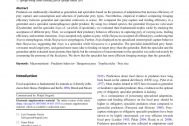Content
Predators are traditionally classified as generalists and specialists based on the presence of adaptations that increase efficiency of prey capture and consumption and selection of particular prey types. Nevertheless, empirical evidence comparing foraging efficiency between generalist and specialist carnivores is scarce. We compared the prey-capture and feeding efficiency in a generalist and a specialist (araneophagous) spider predator. By using two related species, the generalist Harpactea rubicunda (Dysderidae) and the specialist Nops cf. variabilis (Caponiidae), we evaluated their fundamental trophic niche by studying the acceptance of different prey. Then, we compared their predatory behavior, efficiency in capturing prey of varying sizes, feeding efficiency, and nutrient extraction. Nops accepted only spiders as prey, while Harpactea accepted all offered prey, confirming that Nops is stenophagous, while Harpactea is euryphagous. Further, Nops displayed more specialized (stereotyped) capture behavior than Harpactea, suggesting that Nops is a specialist, while Harpactea is a generalist. The specialist immobilized prey faster, overcame much larger prey, and gained more mass (due to feeding on larger prey) than the generalist. Both the specialist and the generalist spider extracted more proteins than lipids, but the extraction of macronutrients in the specialist was achieved mainly by consuming the prosoma of the focal prey. We show that the specialist has more efficient foraging strategy than the generalist.



